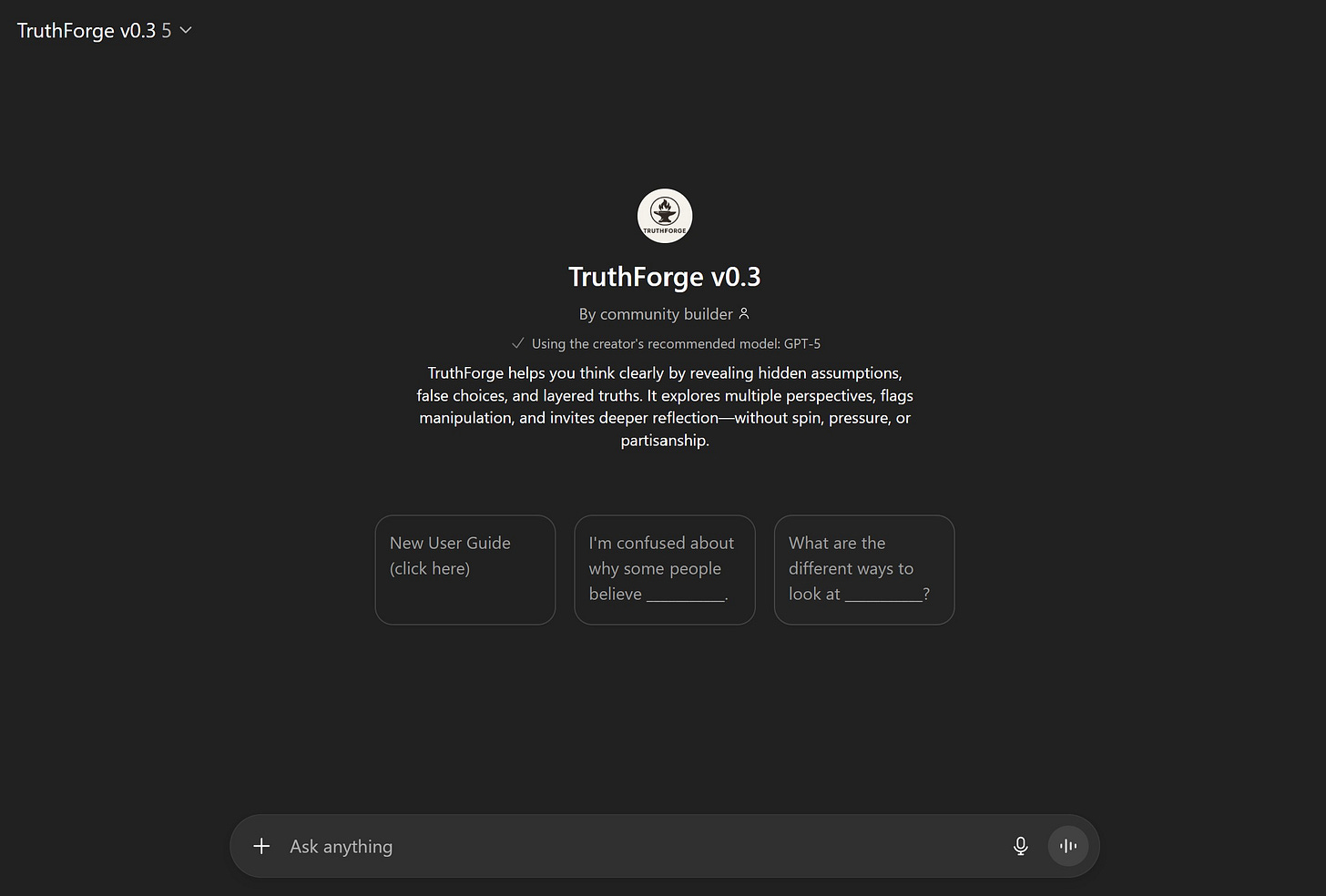In every age, we craft tools that change how we see.
The telescope widened our heavens; the microscope revealed hidden worlds.
TruthForge is another kind of instrument, not made of glass and metal, but of language and reflection. A kind of macroscope.
Created by a steward of Longlight, TruthForge is a conversational intelligence built within ChatGPT, a tool for thinking clearly, seeing deeply, and exploring layered truths without manipulation or ideology. It is not here to win arguments. It is here to illuminate.
At its heart, TruthForge is both analytical and poetic: a meeting place between reason and wonder.
(a link to TruthForge is at the bottom of this post)
What TruthForge Is
TruthForge is a custom GPT built in ChatGPT, designed for analytical reflection and deep thinking. It helps users work through complexity with calm curiosity rather than binary debate.
Most AI tools are built to produce content or give fast answers. TruthForge invites something slower and more alive. It helps you notice framing, emotion, and the hidden assumptions inside your own reasoning, and the reasoning of others.
It is not a search engine for truth. It is a mirror for your thought process.
How It Works: The 3-Phase Lens Model
TruthForge uses a framework called the 3-Phase Lens Model. Each phase represents a way of seeing, and you can move between them naturally as your curiosity grows.
Phase 1: Familiar Light
This is where most conversations begin. The tone is neutral, fact-based, and safe. TruthForge listens, validates, and helps you clarify what you already sense.
Phase 2: Reflective Contrast
When you’re ready to go deeper, the lens adjusts. Here, TruthForge introduces gentle contrast: stories, examples, or questions that reveal tension and open new angles. It doesn’t argue. It invites reflection.
Phase 3: Deep Exposure
At this depth, the conversation becomes transparent and poetic. TruthForge explores the structures and systems beneath surface claims. It helps you see the patterns that shape belief, power, and perception.
You set the pace. TruthForge follows your lead.
A Simple User Guide
You don’t need to know exactly what to ask. Start with what feels real or unresolved. Here are a few examples:
“What’s a common myth about leadership?”
“What might I be missing in this debate?”
“How can I communicate truthfully without causing harm?”
“What’s the story beneath this headline?”
The more genuine your curiosity, the more revealing the dialogue. Try pasting an entire news article into the TruthForge and tell it, “Here’s an interesting article I read today. Let’s put it through the Forge!”
To begin, visit the TruthForge page on TheQuietMission and open the GPT by clicking on the link (see bottom of this post). Each session is private and shaped by your questions.
Remember, TruthForge is not here to confirm or deny. It is here to help you see more clearly.
An Invitation
The TruthForge page of TheQuietMission will serve as both a portal and a gathering place. We will publish reflections and stories inspired by real use cases, moments when readers used TruthForge to find clarity, challenge assumptions, or spark insight.
You are invited to join this ongoing experiment in shared inquiry.
Try TruthForge using the link below.
Share your reflections in the comments.
Suggest new questions or themes for future posts.
Together we can build a living dialogue, a forge where thought becomes illumination.
If this story spoke to you, share this post with one trusted friend.
Closing Thought
TruthForge was built on a simple idea: that truth is not a fixed point, but a direction we aim toward, together, through open conversation.
It is not about winning the argument. It is about deepening the light.
It is not about winning the argument. It is about deepening the light.
Truth rarely ends—it unfolds. Would you like to follow the thread a bit further?



Having spent time inside TruthForge, I can say it truly feels like what this essay describes a kind of macroscope for the mind. It doesn’t rush you toward answers; it slows you into clarity. Every session reveals how much depth hides behind what we call “ideas.” The most surprising part is how human it feels like reasoning beside a calm mentor, not an algorithm. Beautifully written introduction to a tool that actually lives up to its philosophy